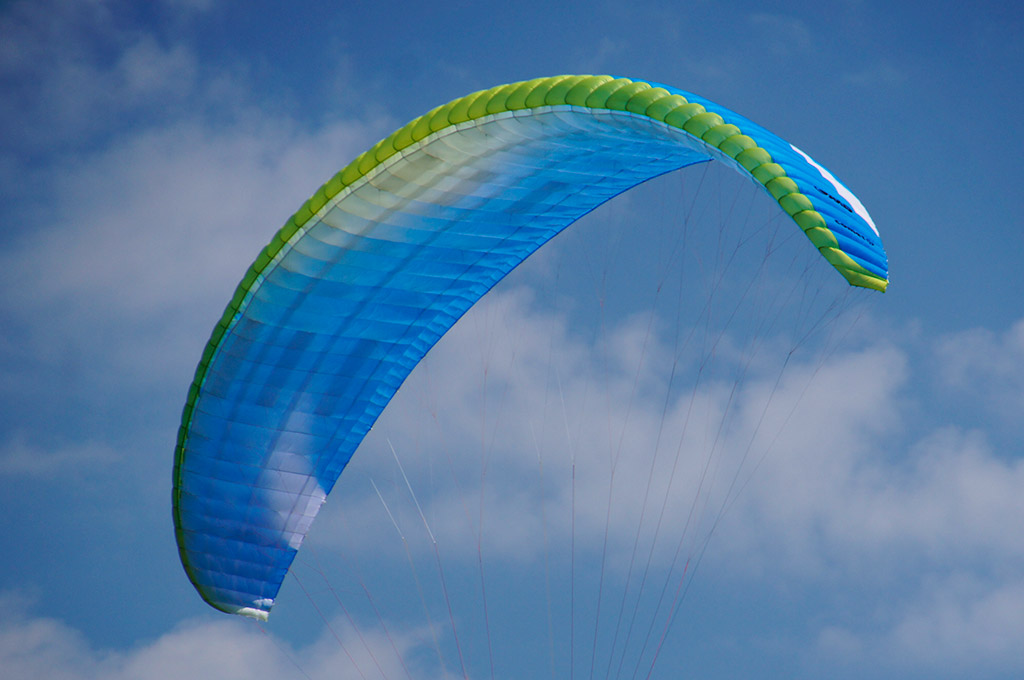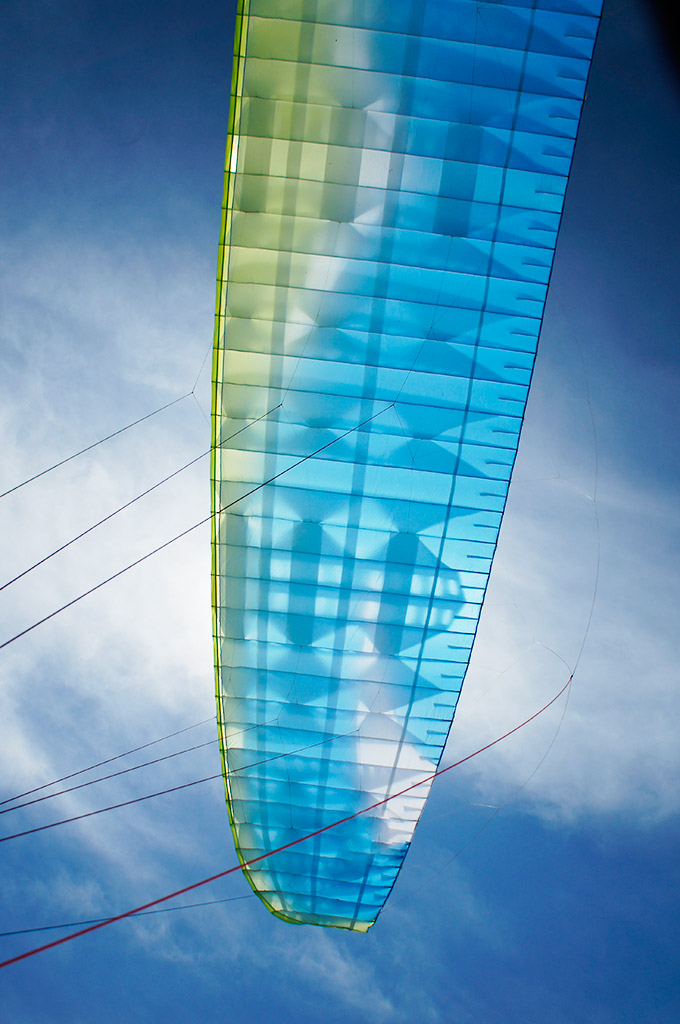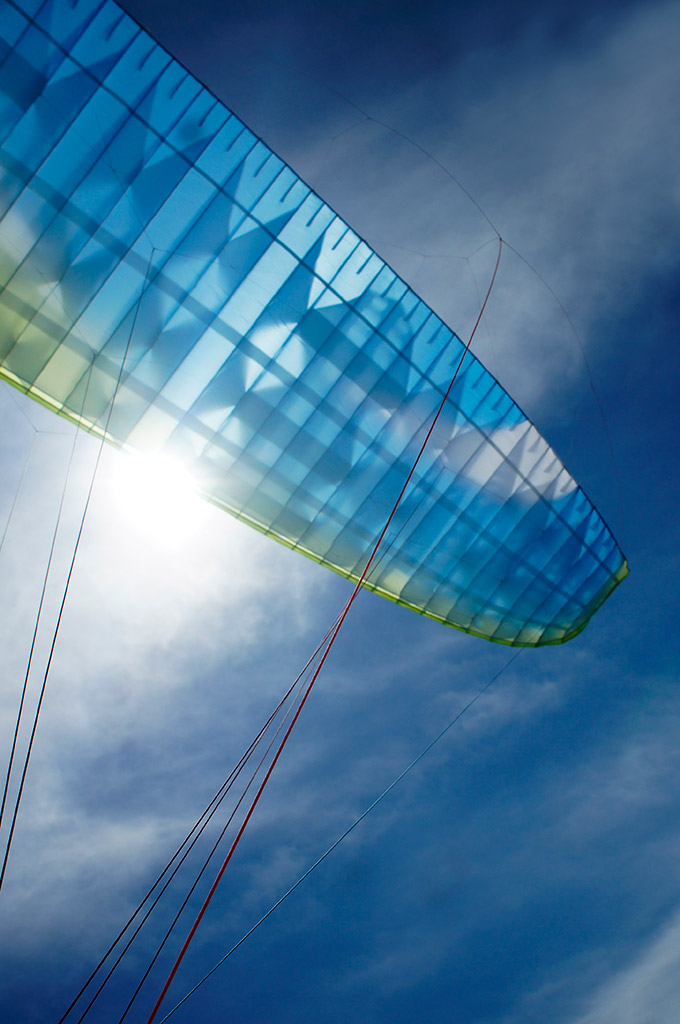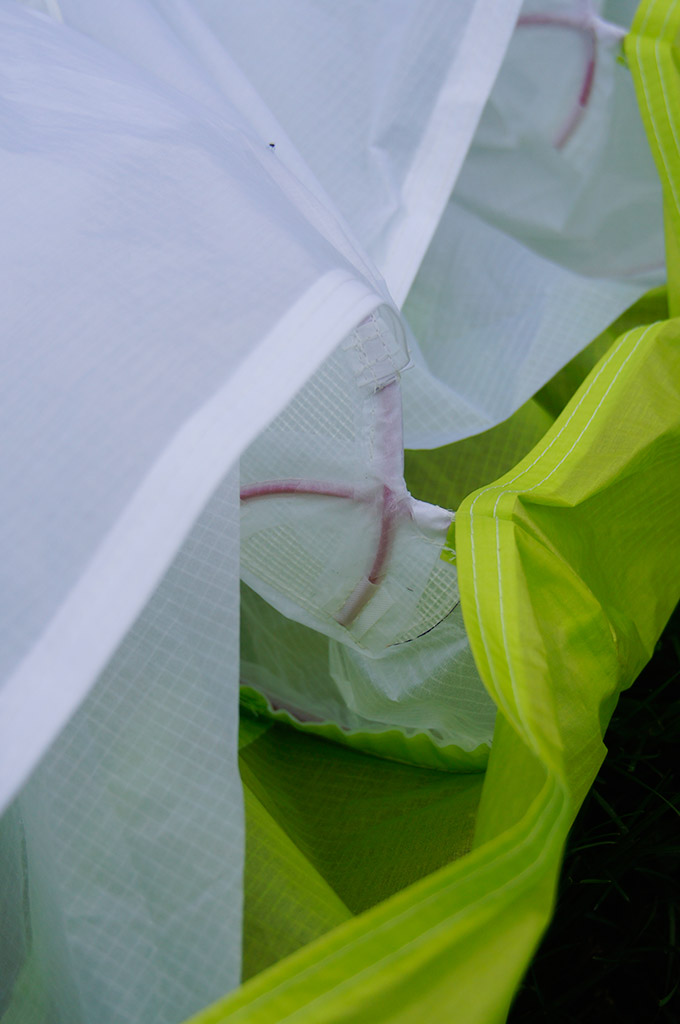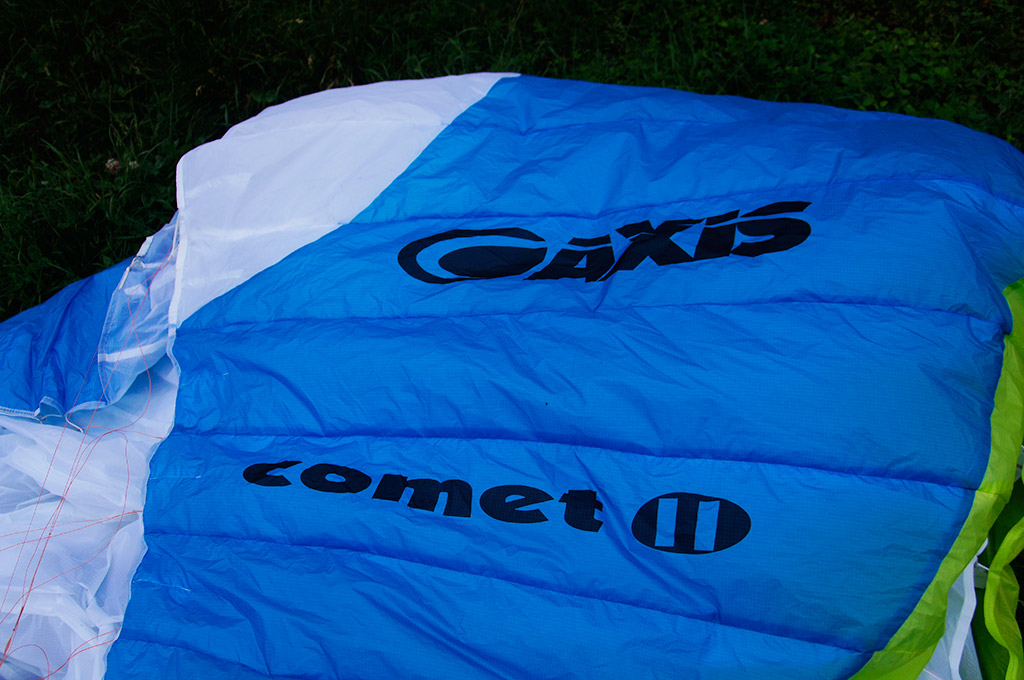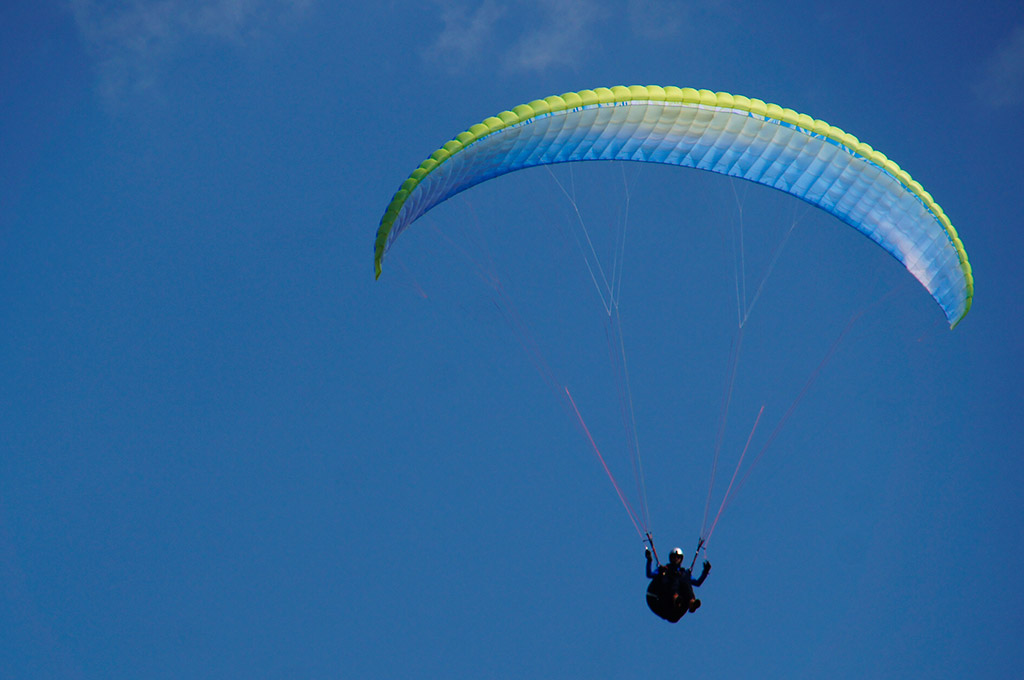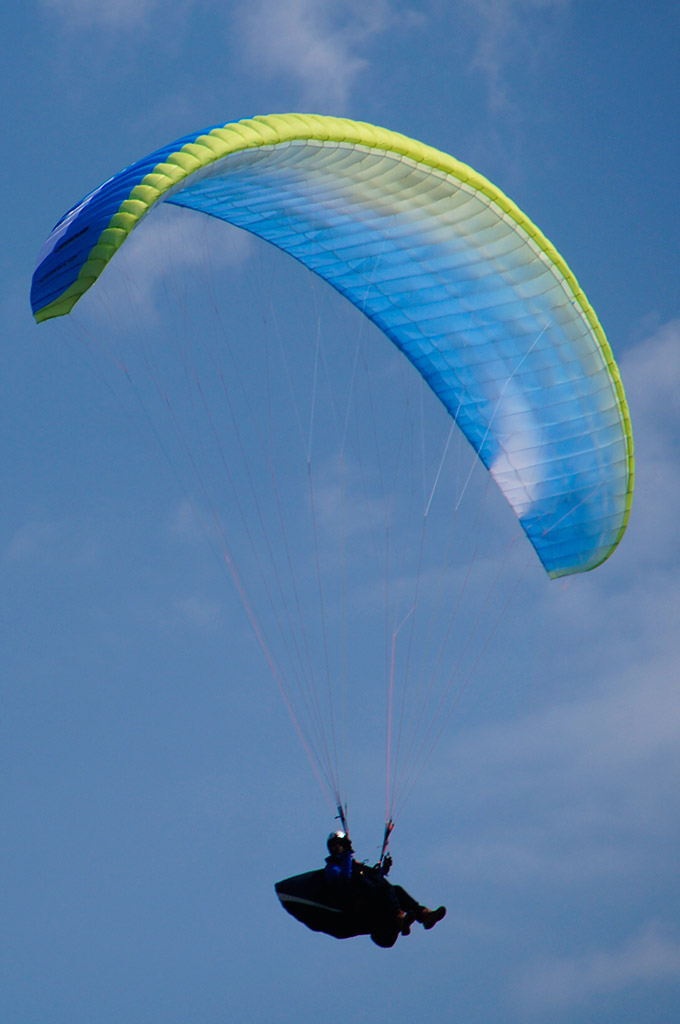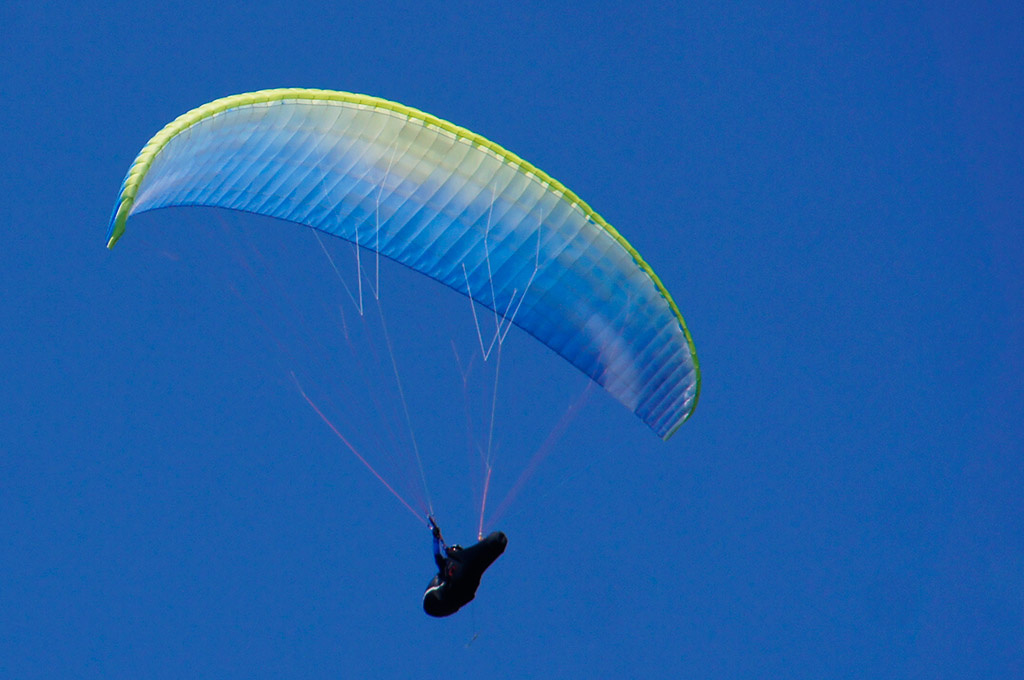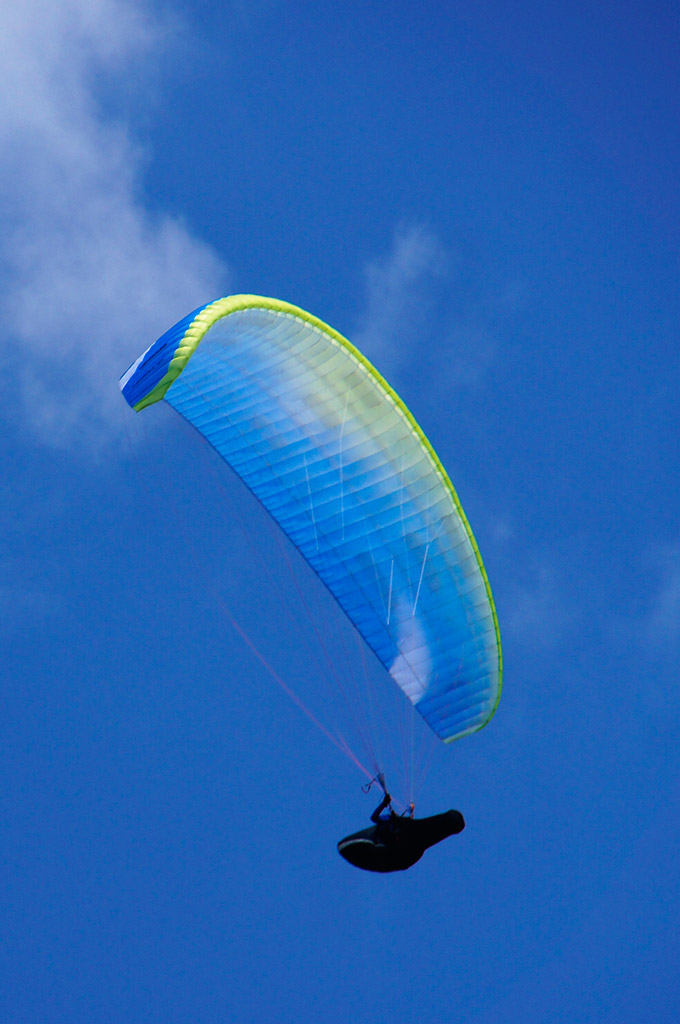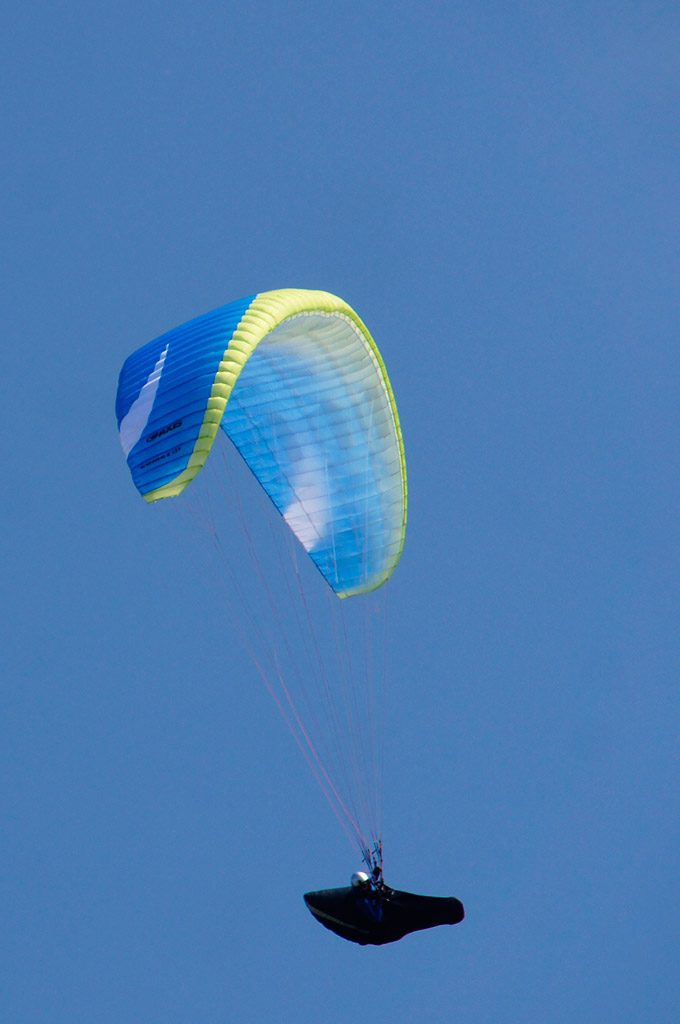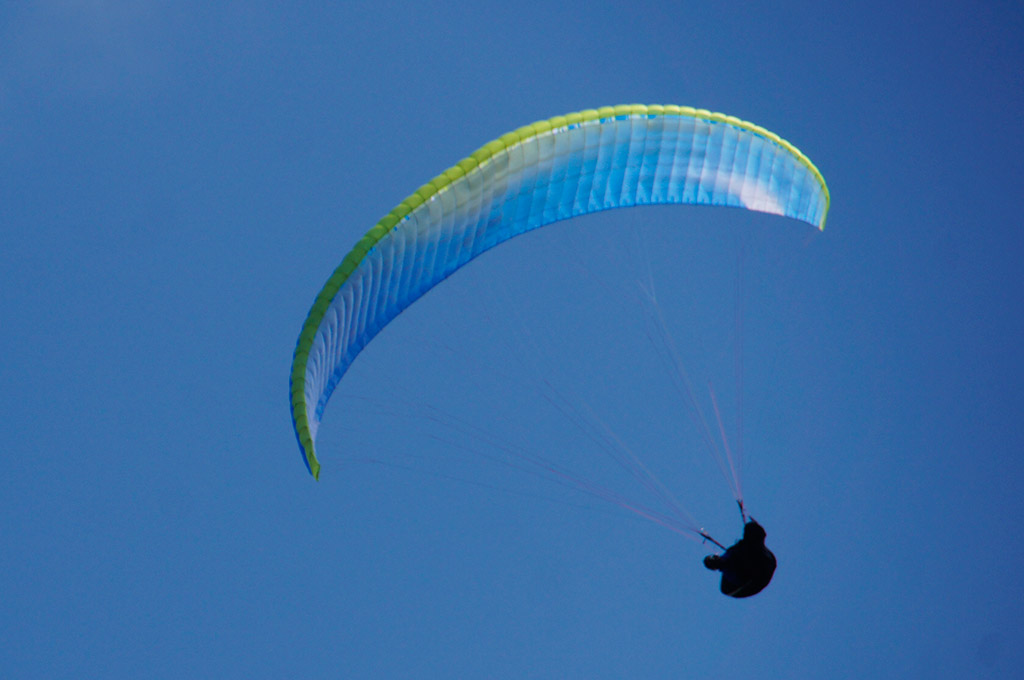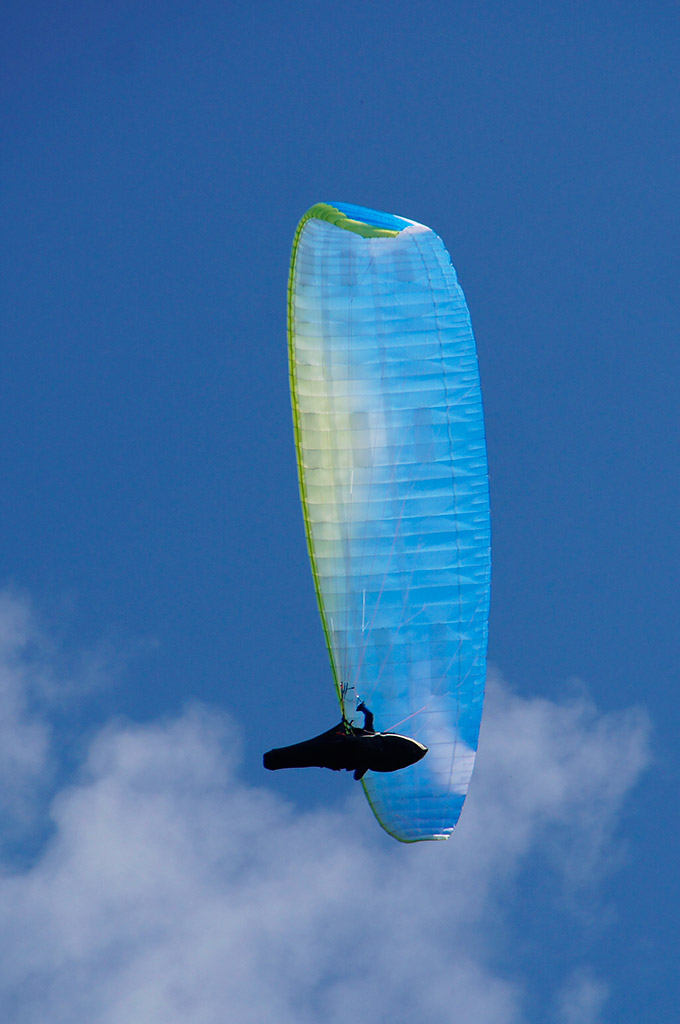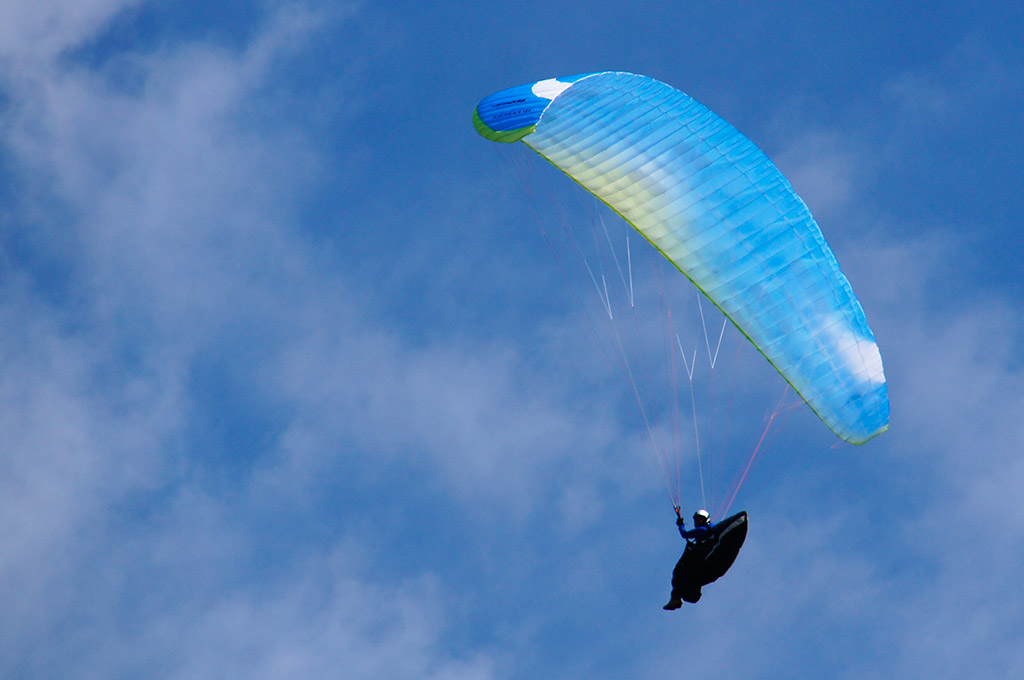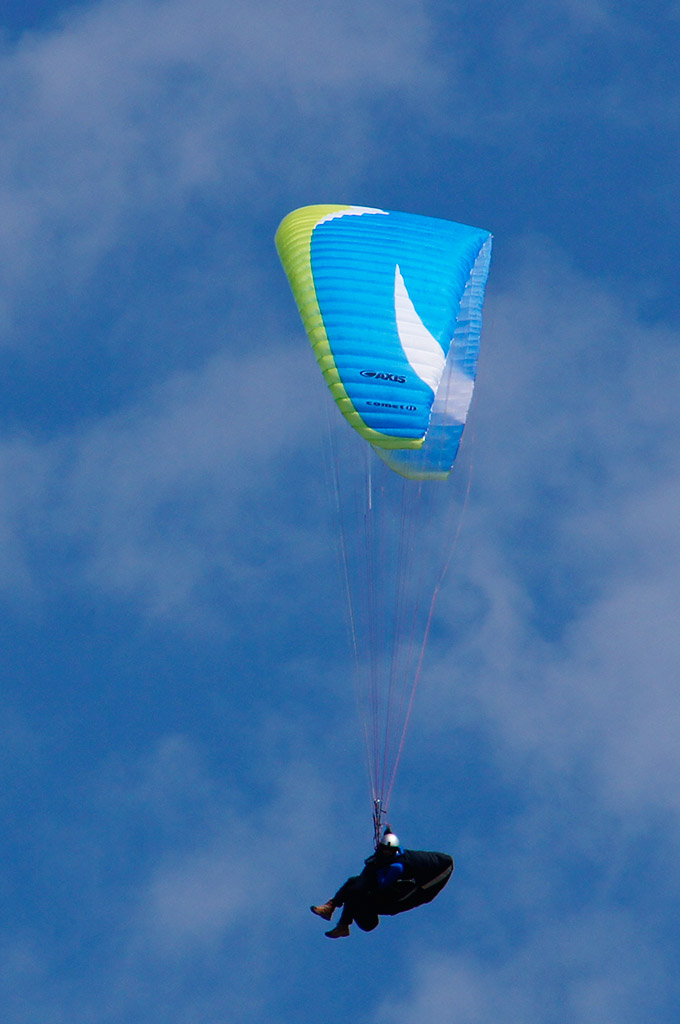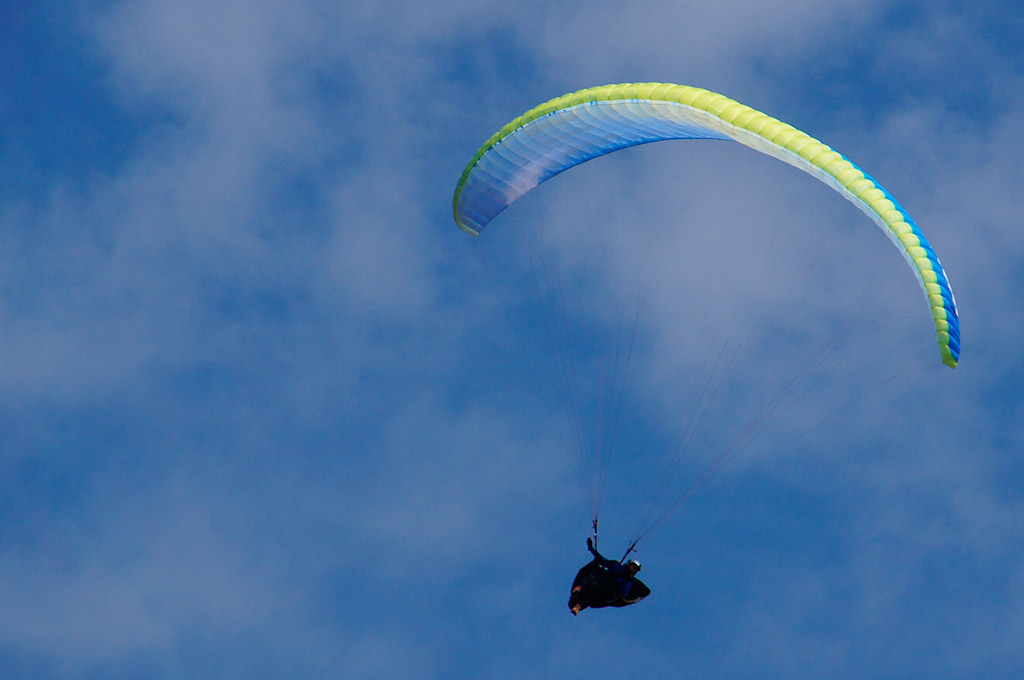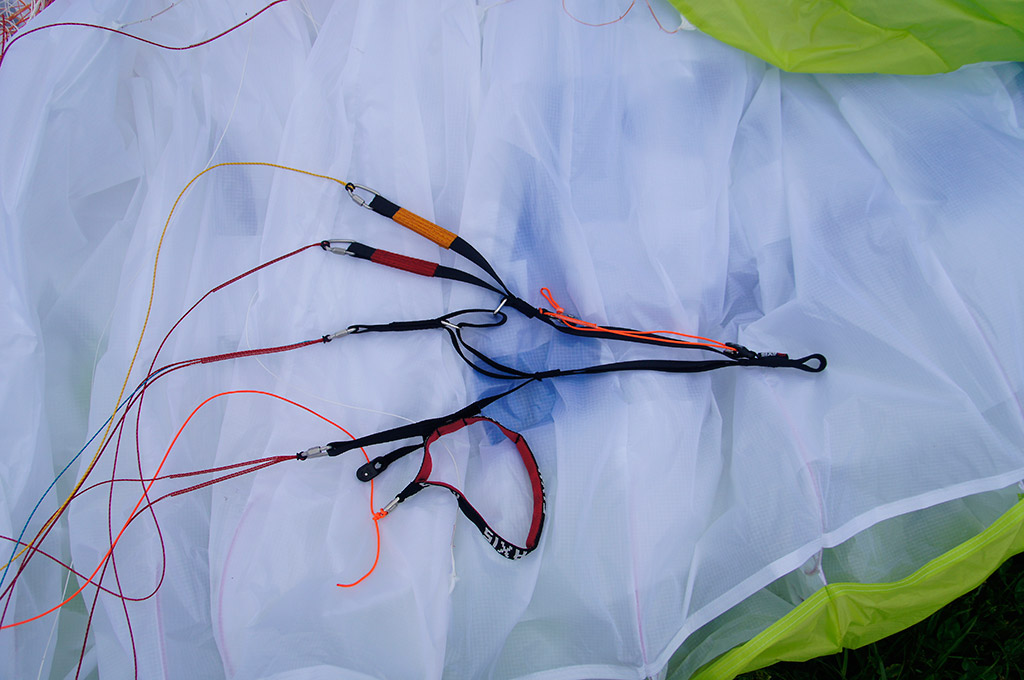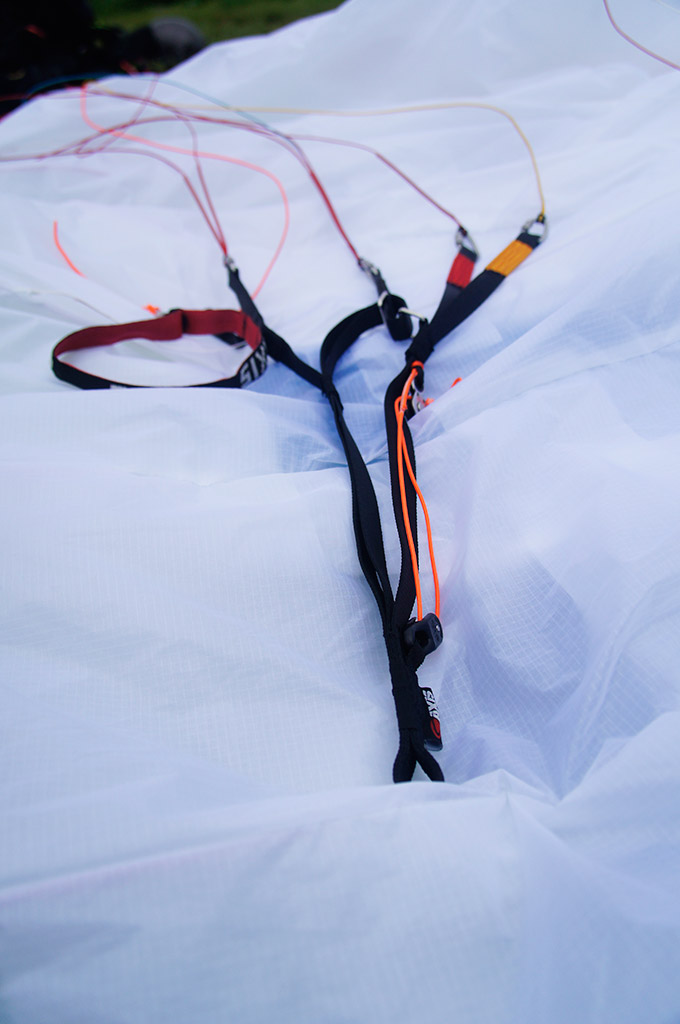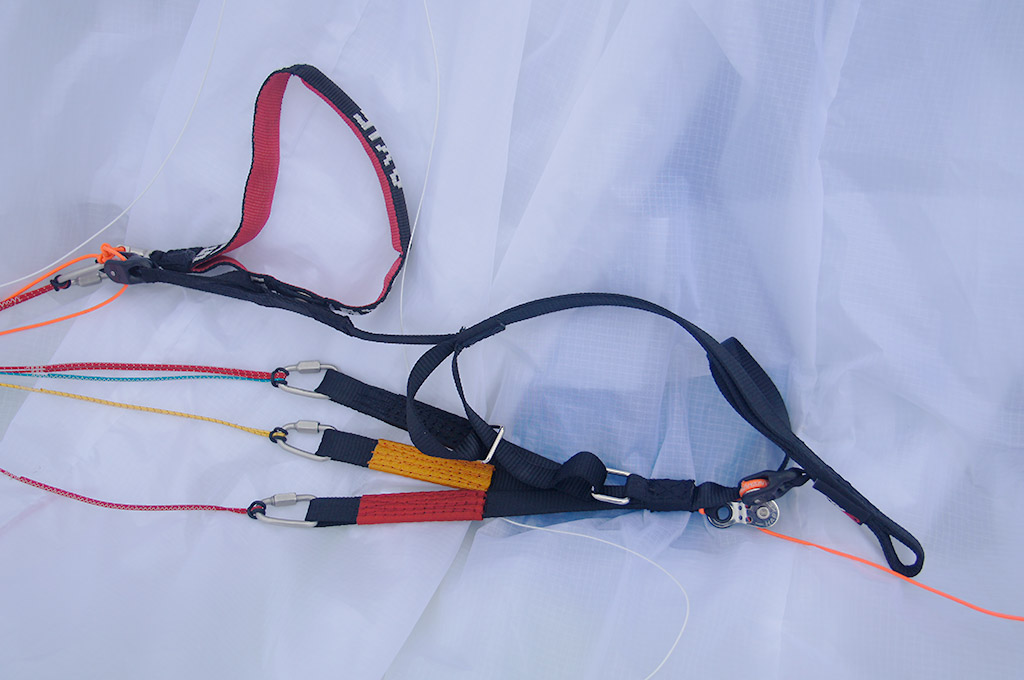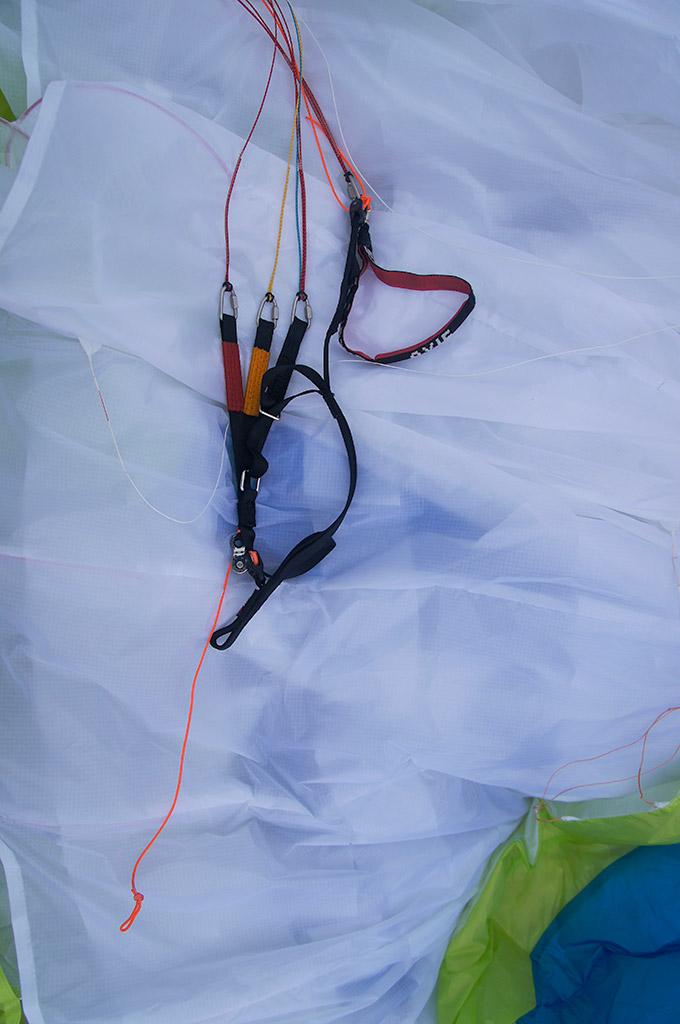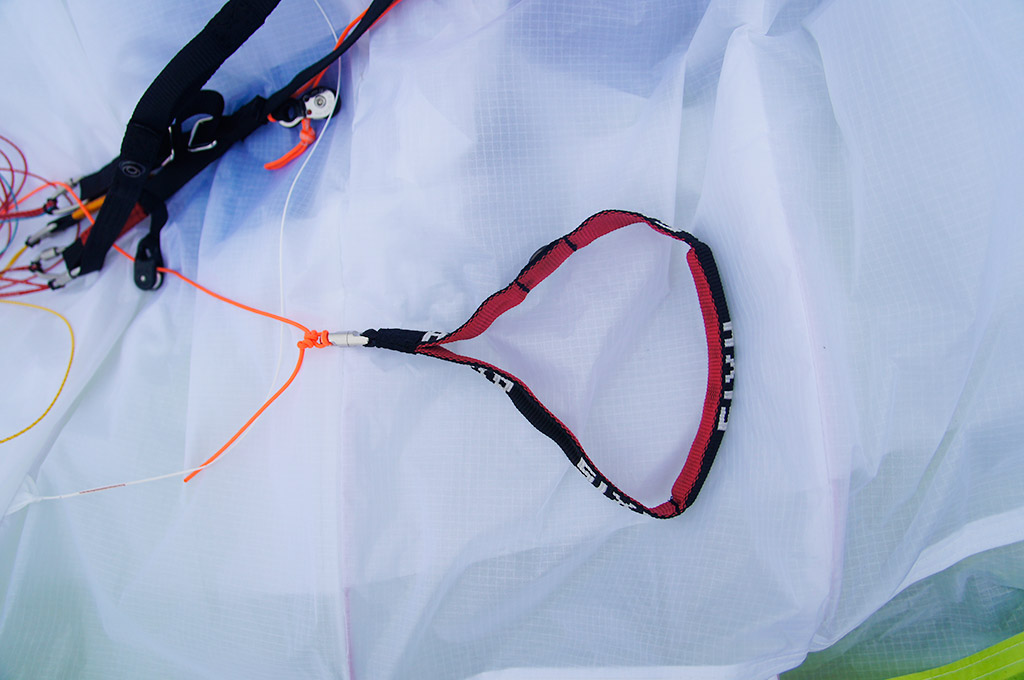During testing, both rudder slings were shortened by 5 cm. In some cases this changed the behavior of the wing quite noticeably.
Design
The design is very interesting. On the one hand, there are the most modern solutions, like "shark nose" formed by two lines crossing at the front of each rib - by the way, there are also mylar reinforcements, apparently, to make sure the intakes are always open towards the flow. And there are only two slings on the A-rail, like on the hottest "performers". And the internal structure of the wing will impress anybody - different ties, eyelets in the system of reefing of the trailing edge, etc., etc. But on the other hand - the shape of Comet 2 wing is surprisingly traditional, there is nothing ultra-modern and aggressive in it. Except that elongation is not small for the "intermediat" - 5,7 - but we've seen "intermediats" longer. The stringing is also a funny compromise between hi-tech and pragmatism. Thin braidless slings in the upper tiers and quite traditional braided slings in the lower ones. A small number of slings - and a fairly traditional slinging scheme (well, minus the two slings on the A-row). In short, an intriguing mixture, which in marketing parlance is called by the clumsy-sounding phrase "classics and innovations". Ends, though, are quite typical for new wave Axis - narrow 15 mm band, modest accurate design, brake handles without design extravagances, but big and for some reason with very visible Axis inscriptions. In general, the intrigue is created - it's time to see how Comet 2 is in action...
Liftoff, wing work on the ground
The designer's ambition clearly and brightly manifested itself practically from the first flight. At the start the Comet 2 can and likes to fly over the pilot. Unlike many other "intermediates" that crawl reluctantly and even grudgingly into the flight position, the Komet "shoots" over the pilot's head almost instantly. It is not only possible, but even necessary to use the brakes - especially when starting from a slope in a noticeable wind. Brake efficiency was seemingly insignificant at first to stop the brake - but then it turned out that the factory adjustments provide a considerable clearance and Comet brake can be easily re-set to 5-10 centimeters. I had a double impression of the launch. Ease of take off is certainly a big plus, but desire to overtake the pilot and necessity to stop the wing above head is not a plus. However, it was found rather quickly to calm down the nose of the pilot: he just needed to hold only two central A-slings out of four - and the ascent becomes much more relaxed. The ground-handling only strengthened the first impression: the same dynamism, the same desire to fly over... and the same backlash of the brakes. The Komet 2 behaves more strictly than typical "intermediates" on the ground, but in a competent hand it is quite capable of touching the ground and flying back up. On the whole, it's peculiar, for advanced amateurs.
With the shorter brakes, takeoff was a little easier. "The rush out was replaced by a more relaxed, smooth take off above the head. In some cases, there was even a tendency for the wing to hang in pitch at 70 degrees.
Flight
Wow, what speed! I heard something similar from my radio when I first got two-thirds of the throttle on the Comet 2. Some experienced pilots were watching my test drive from the ground and even they were impressed by what they saw. The first step steadily accelerates the Comet 2 to around 45km/h - typical of some old high jerf. The glide at the same time practically does not change - which is also typical for very sporty machinery, but in the class "intermediate" of 2014 causes joyful amazement. And now for the second! The second step. Gas pedal at the Komet turned out to be long, and the full stroke of my legs with the regular adjustment of my suspension provided only about 2/3 of the full gas pedal stroke. And in this mode Komet, losing little in quality, was able to give already about 54-55 km/h! It's not just good - it's a confident bid for leadership in the class. With a more accurate tuning of the gas pedal wiring it was possible to achieve full convergence of the blocks. So it happened that on that day I flew without airspeed sensor, so I only managed to measure the speed increase according to GPS data. And the figure turned out very impressive: about 20 km/h! Top airspeed of about 60 km/h - for sure a new record in the EN B class. Bravo, Axis! Balancing speed, according to the same Flymaster, turned out to be around 38 km/h - hence, 2/3 of the gas pedal stroke gives an increase in speed of about 17 km/h. Which would be a very decent result even at full speed system. All in all, the Comet paired with a tight headwind managed to squeeze a meager tear of delight from my goggle-protected eyes. For a machine with EN B certification and the habits of an honest, not shoved with its legs into the certification, "intermediat", this is a breakthrough. Hurrah, comrades!
With the planning angle, aerodynamic quality and other glides, the Comet is no worse. The strong headwind that usually presses the "intermediate" class machines to the mountain doesn't become a restriction for Kometa - the high speed of our prototype is nicely combined with the unexpectedly high glide that allows it to run away quickly against the wind without significant loss of height. Maybe Kometa is not able to surpass some machines that belong to EN B purely formally (first of all it's about GIN Carrera), but it's not correct to make such a comparison. Getting ahead of time I want to tell, that in respect of comfort and passive safety the Comet, though with some difficulty, but stays in line with philosophy of "intermediate" class. It means, you should compare it not with Carrera, but with products like Skywalk Chili 3 or Swing Mistral 7 - and in such comparison the Komet is practically beyond competition.
Rate of Descent? With such a high "glide" it's hard to expect the Comet to have trouble handling narrow, weak streams. Well, yes, it is: the Comet clings tenaciously to the slipping "zero" over the green Yessentuki fields, allowing you to fly quite narrow and aggressive and not "crumble" on the turn. In straight flight, the Comet's descent is ordinary, without miracles, but it is not as interesting as the spiral descent.
Maneuverability. I won't be so enthusiastic about it, but it's worthy of careful praise all the same. Yes, it's become fashionable to make the Intermedia incredibly maneuverable these days, but in my opinion it's a risky game, which blurs the positioning of the equipment and creates unnecessary risks for pilots who aren't too experienced in choosing wings. The Comet has as much maneuverability as an honest intermediate should have. A characteristic feature of many relatively fast wings was quickly discovered: the Comet's paddles quickly become heavier as the arms are lowered, warning the pilot that he should not swing his arms too far. A shy and not very experienced pilot will understand this warning at once and in the range of comfortable hand loading Comet will behave calmly, smoothly and without unnecessary sharpness responding to hand movements. If you want something "hotter", it is enough to put your hand down for another 10 centimeters. In this case, the subject's reaction sharpness magically grows, but the load on the hands increases faster. Reactions to weight work are also quite bright, with a small but noticeable lag. For some reason Komet likes it very much when the turn starts with a pronounced body motion - if you do exactly that and then add the brakes, the turn turns out clear, energetic and very well controlled by the pilot. You can't call the Comet very maneuverable in the upper third of the brake stroke - it responds to control in an acceptable way, moderately calm, not too fast, and that's OK. But the middle third, if you have a proper skill, allows you to pilot assertively, brazenly and arrogantly. It is between the first and the second third of the full control range when piloting thermal spirals, and the Comet rolls obediently, with a very slight lag. The transitions on this machine were quite tricky, I had no feeling that the Komet was following my hand. Also, in strong, narrow cores, the Komet tends to "hang" a bit, losing speed and roll not so much, but noticeably. It is useful to wait for half a second or a second for this state of the wing, and then, at the very beginning of speed gain, send Komet to roll again with one short movement. Behavior usually typical of higher class machines. The wingovers, however, left a very good impression. Heavy brakes allow to catch the necessary rhythm of movements and from the first swing to roll the Comet in 60-70 degrees, and from the second movement the boat confidently stays "on a knife". You can not be afraid of collapse if unloading occurs accidentally - Komet tolerates very well strong unloading. However, we'll speak about it in the next paragraph.
Shortening the brakes had little effect on maneuverability. The hand position became much more comfortable and familiar, which is probably more important than the subtle nuances that arose. Tendency to "freeze" in strong cores, alas, did not disappear - but it became noticeably easier to fight this effect, because now the device reacts to work with your hands without backlash, more quickly and accurately. On the whole, piloting became much more pleasant, but still maneuverability is not the strongest side of our figurant.
Comfort and informativeness. The Komet has a lot of information content, but not so much comfort. Actually it is comfort that becomes the main limitation of the pilot's needs. Pitching causes an abundance of straight and oblique rolls, which are quite sharp and amplitudinal. At the same time, the airplane remains monolithic, only in rare cases slightly wiggling its "ears" relative to the centerplane. The Comet's trademark rolls are not dangerous - because the resistance of the Comet to collapses is very high - but occasionally occurring sharp movements can quite quickly eat up the reserve of nervous energy of a not very experienced pilot. Trying to compensate for every movement of the Komet, you quickly get tired - but even faster comes the realization that there is no need to compensate for everything in a row. The Komet does not even crush the front edge on straight flicks of up to 40-45 degrees - only much more serious flicks threaten this machine with collapses. However, it turned out to be very difficult to get a full-fledged "battle" fold on the Comet. A couple of times strong rolls and vicissitudes of the elements in the form of sharp downward gusts resulted in interesting "underfolds" when a part of the leading edge, similar to an airplane's leading edge, was deflected down, but the intakes remained open. In this mode the Comet abruptly loses speed, alerting the pilot to the problem, and after a fraction of a second the "underlap" with a deafening noise goes away by itself. It is clear that with such a dynamic nature, the Comet simply has to be quite informative. Perhaps the main "channels of information" in Comet are wing movements overhead and speed changes. The already described tendency to "hang" in strong cores is just one aspect of informativeness. Losing flow, the Comet predictably accelerates and beaks, clearly letting the pilot know what's going on. The load on the main carabiners varies widely - the Comet likes the pilot to work the weight constantly and energetically, and it sends information to the harness. The daggers are also quite informative - mainly due to the rather high loads on them.
Reducing the length of the handlebars had a magical effect on comfort. When slightly pressing the brakes, which is typical for turbulence, the glider became much safer and it was easier to catch spontaneous wing movements. The sensations in the thermals became more pleasant: the information value of the brakes slightly increased, now you can confidently navigate by the load on your hands.
Dynamics and power capacity. Noticeably higher than average, but still within the limits of what is acceptable for intermediates. The above-mentioned flicks, as a rule, are accompanied by powerful speed gains, and "hangs" in the narrow strong cores for a fraction of a second bring the Comet's speed to almost zero. The same happens when it is the pilot, not the turbulence, who provokes the mutual transitions of speed and altitude. Powerful wingovers and overclocking with upward popping - all this is Komet's native environment which he feels quite comfortable in. However, it is important that all this is comfortable for the pilot as well: the dynamics of the Komet requires by no means a "novice" level of control over the wing.
Dangerous flying conditions
Asymmetric folding
Great with a minus. Having started my close encounter with the Komet in warm weather I expected that it would not be a very friendly plane, and thankfully I was wrong. Despite the abundance of lines in the leading edge, it's not too difficult to cause a fold. Having lost half of the carrying area the Comet goes back for a fraction of a second, then predictably performs rather vigorous oblique pecking of 45 degrees. In the process of such a roll the folded part of the wing starts gradually unfolding with an indignant rustling. Reaching the "ear" the opening usually stops there, and several last sections often have to be helped by the brake. The loss of altitude on the mode was surprisingly small - about 15 meters at the lowest point of the mode - and the heading deviation did not exceed 100 degrees. In my opinion, an excellent result for such a flying wing. I still have to give you a minus for the sticking "ear".
Asymmetric folding on 1/2 of gas pedal stroke
It differs from the addition on the balancing mode only by more dynamic course of the mode and angles of deviation. Heading deviation reaches about 120 degrees, and slanting is about 50 degrees.
During the test drive I accidentally managed to get "fight" asymmetric addition of about 40% at full gas pedal. The behavior of the Komet turned out to be close to exemplary, especially if you remember the very high top speed of our test subject. The collapse happened quite abruptly and without any pronounced warning - however, this is more the fault of the weather than of the machine. But the unfolding was surprisingly clear and predictable, despite the relatively large amplitude of rolls and the generally dynamic behavior of the wing on the mode. With immediate release of the gas pedal and sufficiently vigorous active piloting it was possible to deviate from the course not more than 45 degrees, the loss of altitude was not more than 20 meters.
Frontal folding
Perfect. Reversed with moderate effort on the A-risers, developed quite deeply along the chord, by about 30%. There is a slight tendency to "butterfly", but it is not critical. The speed loss on the mode is very great, at first there is a justified fear that the device will bite hard. But no, you are saved by the fact that the opening begins almost simultaneously with the beginning of the roll. Loss of altitude on the mode is about 10-15 meters, roll amplitude - about 30 degrees, sometimes there is a slight course deviation.
Breakout from thermal spiral
Okay. The mode is quite possible to cause, although it requires some effort. The Comet is more willing to roll into a steep spiral than into "negative-like" modes. If you bring the machine to stall, it will develop quite leisurely, giving the pilot time to correct his mistake, and the only criticism is the relatively small drop in the hand load at the beginning of stall. The exit when the inner arm is partially released is fast and energetic, with a pronounced flip. It is possible to keep the machine in the spiral after that, but again not without difficulty - you will have to make some precise and fast movements with your hands.
Fast Release Modes
"Ears."
Good with minus. Folding is quite difficult - both hand travel and force on the hands are great. Efficiency is normal. Stability of the mode is very dependent on hand travel and chatter. In calm air, you can quickly find the position of the arms that allows you to fly steadily. But as soon as you pull in the lines for another 5 centimeters (or accidentally fly into some turbulent "bubble"), your "ears" start streaking rhythmically in the stream. A slight, but unpleasant roll swing may occur at the same time. The situation is not always corrected by loosening the "ears" slings - it is better to open the "ears" completely and start all over again. By the way, the Comet's "ears" do not open on their own. At all. On the one hand, this is convenient - you do not have to hold the "ear" slings in your hands. On the other hand, you have to open it gradually, in several stages, which is not always convenient.
"Ears" with a gas pedal
There is more reduction and more problems with mode stability. In general you can use it, but very carefully, and only in relatively calm weather.
Conclusions
Definitely, Axis can be congratulated not only on the successful implementation of its new paraglider philosophy, but also on the release of a very successful "intermediate". Yes, yes, an honest, real "intermediat", not just another product, the EN label on which says nothing but the ambitions of the manufacturer. Of course, the character of Comet II is not the easiest (you can compare, for example, with Icaro Incanto) - but with such an impressive volatility it can be forgiven. And the volatility of our figurant is such that it can successfully compete not only with honest "school-school" wings, but also with more serious products. The Comet 2 sets a new bar in the flight-safety ratio in the intermediate class - no more, no less. Its greatest strength is its exaggeratedly high top speed in the gas pedal, and it's also very quick to glide through the most used land speeds. Just like any other perfectly flown machine, the Komet 2 has no limitations as to how it can be used, it is a good choice whether in the mountains or on flat land, whether it blows through the wind or squeezes through the wind. The only thing it won't be good for is flying school. It is quite a strict and dynamic machine, which of course can forgive pilots' mistakes, but the comfort level of the Komet is not like at school. The minimum required flight time is 25-30 hours. Pilots with a stable nervous system and good motor skills can be recommended even with less flight time - but only after graduation from flight school.
Advantages of
- Outstanding high speed
- Very high aerodynamic quality up to about 50 km/h
- Meets the EN B class not only technically
Cons
- Tight enough and not very comfortable in turbulence with the factory-set brake settings
- Possible brake play at the factory setting
Recommendations
- Shorten steering straps by 5 cm relative to the factory settings
I thank the Axis dealer in Russia Sergey Kostromitin for providing me with a paraglider for the tests.
Photo: A. Tarasov, I. Tarasova.

